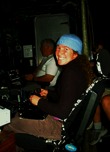 |
Deep
Sea Bacteria Spin Rust and Eat Nails for a Living
The microbial mats at Loihi can be thought of as a giant fabric woven together by the microorganisms that grow there. It is the bacteria that are responsible for spinning the iron oxides into the filaments or threads that create the larger mat fabric. What is remarkable is that this ‘yarn’ is composed mainly of rust, which is what most of us think of when we see oxidized iron. So far, we have only identified one bacterium that we are sure is involved in forming the helical twisted filaments or stalks.
But what about the tubular and Y-shaped structures?
Read this
preliminary science report by Dave Emerson ... |
|
 |
My
First Time at Sea 1
Even
though I worked with the Navy for a couple of years, I never got to
go out on a submarine or carrier, so the FeMO2007 cruise was my
first time out at sea. My first couple of days were spent mainly
trying not to be seasick, with amounts of work interspersed in
between. The hydrothermal vents, chimlets, pillows, and mats at the
bottom were amazing to see. Read this
report by Graduate Student En Chieh Chen ... |
|
 |
In
Situ Electrochemistry at Loihi and the AIS ISEA™ III
The
purpose of the ISEA (In-Situ Electrochemical Analyzer) is to be able
to describe chemically the environmental habitat of micro and mega
fauna at the bottom of the ocean. The instrument can also be used to
investigate diffuse and hydrothermal vent sites to aid geochemists
in characterizing these very different underwater environments.
Read this explanation on
Electrochemistry by Don Nuzzio ... |
|
 |
Dr.
Suz's FeMO Cruise Blog
Microbiologist and post-doc Suzanna Brauer has been cooking up bacterial media by the gallons down in the hydro lab of the R/V Kilo Moana. This soupy brew she will use to let Fe- and Mn-loving bacteria from Loihi Seamount grow and multiply so she can study them in her laboratory back home in Portland,
Oregon. Follow Dr.
Suz's adventures in this
special FeMO blog ... |
|
 |
FeMO in the classroom through SERC!
FeMO collaborator and high school teacher Shawn Doan is helping out not only with disseminating FeMO results to a broad high school audience through the FeMO website. He is also part of an emerging collaboration between ERESE and the pedagogic services of the Science Education Resource Center (SERC) at Carleton College.
Check out his lesson plan on teaching the carbon cycle with a consideration of chemosynthesis ... |
|
 |
My
First Time at Sea 2
Back in Colorado I have been working on hydrogen generation experiments to optimize the production of H2 from the interaction of rocks, minerals and metals with water in a way that it can be used to culture micro-organisms.
These serpentinization reactions result in the production of H2 gas and often takes place deep within the Earth's crust
and maybe
even within the crust of Mars. The gasses released from this reaction can percolate through the crust and be vented at the Earth's surface, often at the bottom of the sea. The active vents on Loihi are an excellent place to look for micro-organisms that may be able to harness the energy available from
these reactions. Read this short
report by Graduate Student Lisa Mayhew ... |
|
 |
An
Opportunity to Link Chemistry and Microbiology at Marker 39
M39
seems to be one small area where you can observe a snapshot of how dynamic the entire
area of Pele's Pit can be. Essentially there are Fe-rich areas, sulfide-rich areas, hot fluids, cold fluids, and visible differences in the structure of the microbial
mats. It looks like this is an excellent place to explore fundamental questions about how the chemistry of this system defines who (microbiologically) is present and
active. Read this short
report by Alexis Templeton ... |